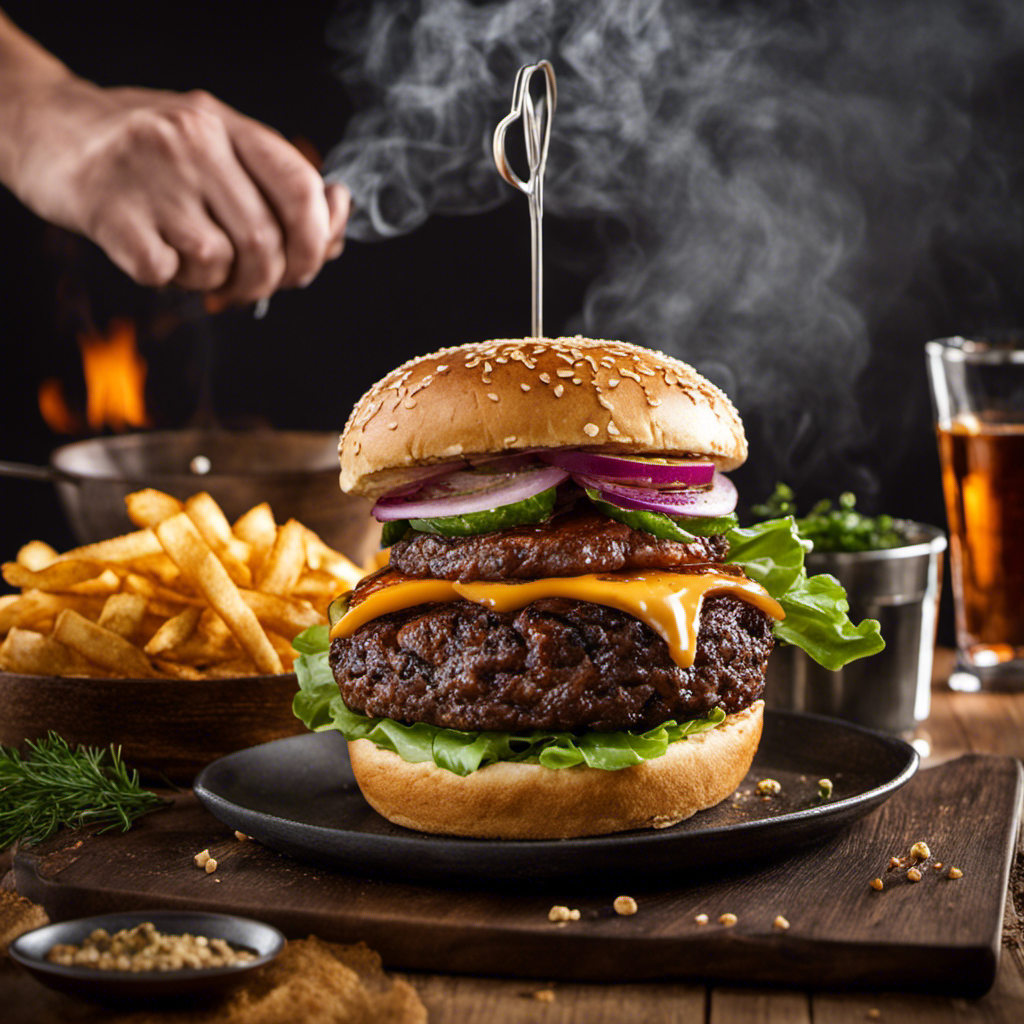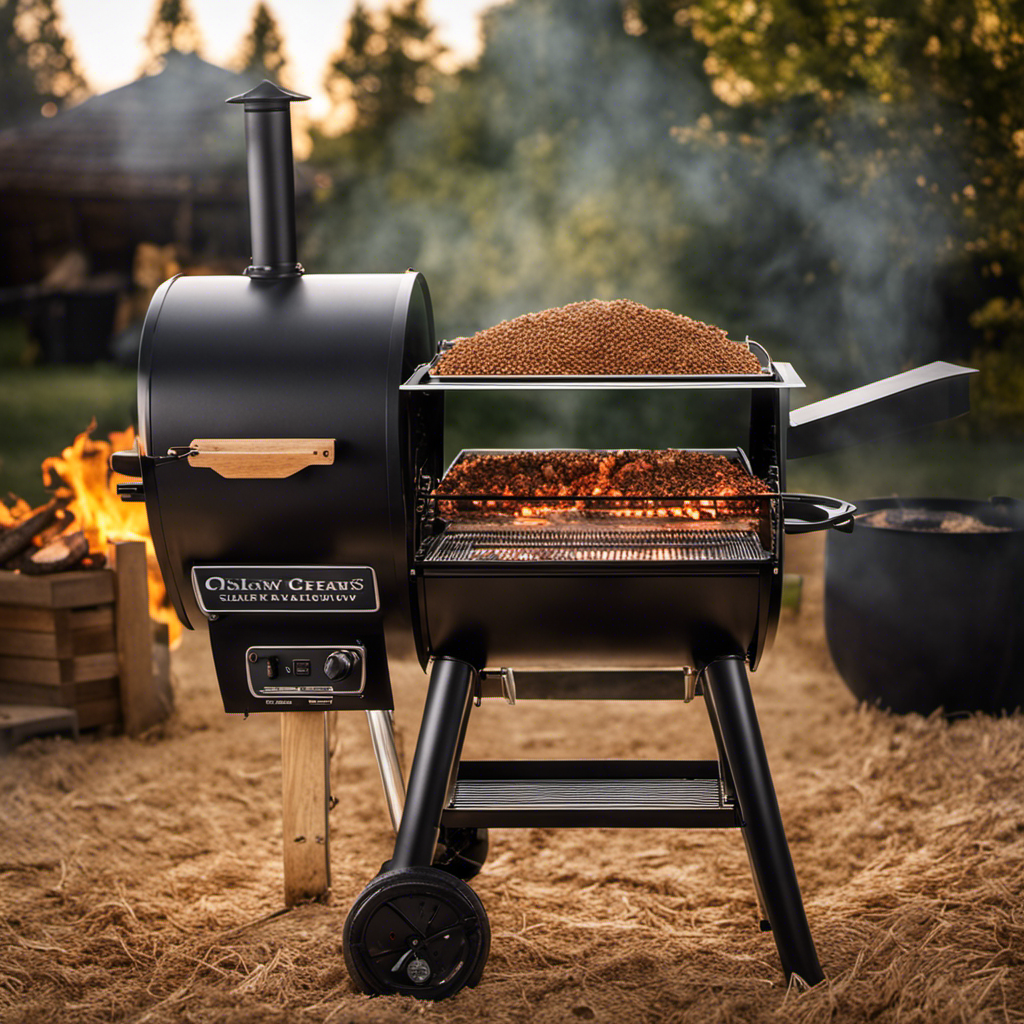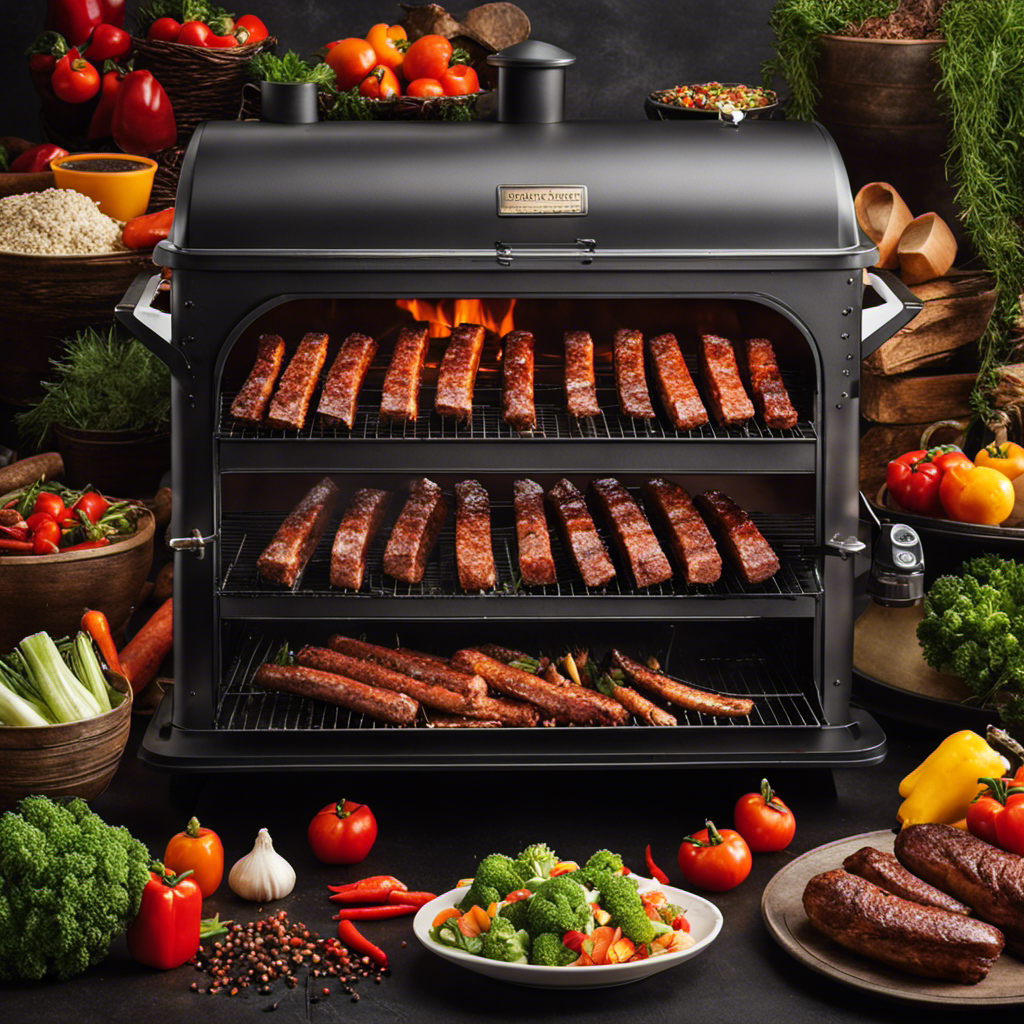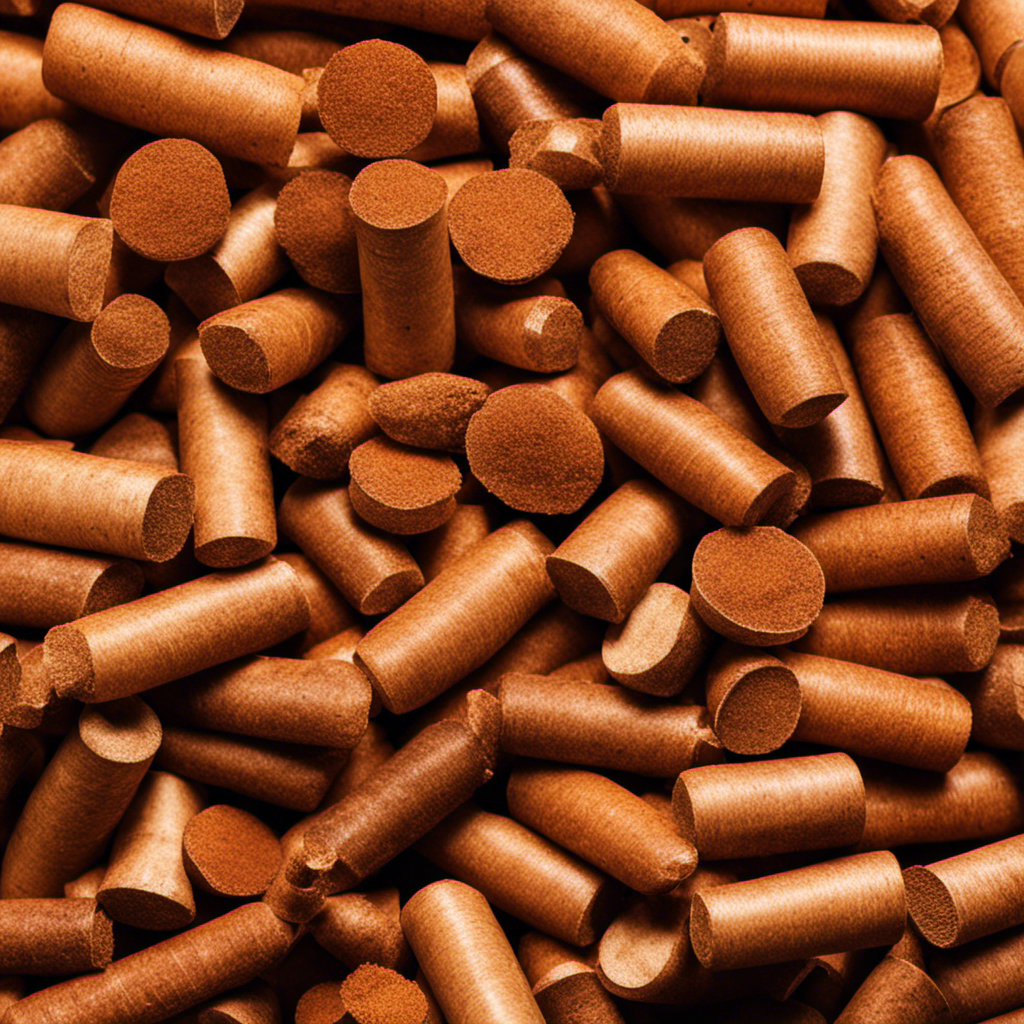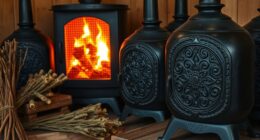I’ve always had a deep appreciation for the crackling noise produced by a flawlessly grilled ribeye steak. There’s an indescribable quality to the scent of burning wood coupled with the moist, succulent meat that just makes my mouth water.
If you’re like me and want to take your grilling game to the next level, then cooking a ribeye steak on a wood pellet smoker grill is the way to go. In this article, I’ll walk you through the process step by step, from choosing the right cut to serving up a mouthwatering masterpiece.
So grab your apron and let’s get started!
Key Takeaways
- Select ribeye steaks with abundant marbling for rich, juicy flavor and tenderness.
- Choose pellets that complement the type of meat you’re cooking, such as hickory, mesquite, apple, cherry, or pecan.
- Maintain a consistent temperature throughout the grilling process for optimal results.
- Season the ribeye steak with kosher salt, black pepper, garlic powder, and optional herbs for enhanced flavor.
Choosing the Right Ribeye Cut
You’ll want to make sure you choose the right ribeye cut for the best results on your wood pellet smoker grill. When it comes to ribeye cooking techniques, selecting the right cut of meat is crucial. Look for ribeye steaks with abundant marbling, as this fat distribution throughout the meat is what gives it that rich, juicy flavor and tenderness.
The marbling is essential because it melts during the cooking process, infusing the steak with its incredible taste and moisture. Opt for ribeyes with a good amount of marbling, ensuring a delicious and succulent result when cooked on your wood pellet smoker grill.
Now that you have the perfect ribeye, let’s move on to preparing the wood pellet smoker grill for the best cooking experience.
Preparing the Wood Pellet Smoker Grill
When it comes to preparing a wood pellet smoker grill, there are a few key points to keep in mind.
First, choosing the right pellets is important. The type of pellets you use can greatly affect the flavor of your food. It’s important to choose ones that complement the type of meat you’re cooking.
Second, temperature control is crucial for achieving the perfect cook. I’ll be sharing some tips on how to maintain a consistent temperature throughout the grilling process.
Lastly, proper cleaning and maintenance are essential. This will ensure that your wood pellet smoker grill performs at its best and lasts for years to come.
Choosing the Right Pellets
To ensure optimal flavor and smoke, it’s important to choose the right pellets for your wood pellet smoker grill. The type of pellets you use can greatly influence the taste of your food.
There are various pellet flavors available, including hickory, mesquite, apple, cherry, and pecan. Each flavor imparts a unique smoky essence to your meat. For a bolder, robust flavor, hickory or mesquite pellets are ideal. If you prefer a sweeter, fruity taste, apple or cherry pellets are excellent choices. Pecan pellets provide a milder, nutty flavor that pairs well with a variety of meats.
When selecting pellets, consider the smoking techniques you plan to use. Some pellets are better suited for low and slow smoking, while others are perfect for high-temperature grilling.
Now that we’ve covered choosing the right pellets, let’s move on to temperature control tips for your wood pellet smoker grill.
Temperature Control Tips
Maintaining the right temperature is crucial for achieving the perfect smoky flavor in your food. When cooking ribeye steak on a wood pellet smoker grill, temperature control techniques are key to ensuring that your steak is cooked to perfection.
Start by preheating your grill to a high temperature, around 450°F, to achieve the perfect sear. Once the grill is hot, you can lower the temperature to your desired cooking level. For a medium-rare steak, aim for a temperature of around 130-135°F. Use the grill’s built-in thermometer or a reliable meat thermometer to monitor the internal temperature of the steak. This will help you achieve the ideal level of doneness.
Proper cleaning and maintenance of your wood pellet smoker grill is essential for its longevity and optimal performance.
Proper Cleaning and Maintenance
For optimal performance, make sure you regularly clean and maintain your grill to extend its longevity. Here are some cleaning techniques and a maintenance schedule to keep your grill in top shape:
- Remove any leftover food and debris after each use by scrubbing the grates with a grill brush.
- Clean the interior of the grill regularly by wiping it down with a damp cloth and mild dish soap.
- Check the burners and gas lines for any blockages or clogs, and clean them if necessary.
- Inspect the grill for any signs of rust or wear, and touch up any areas with heat-resistant paint.
By following these cleaning techniques and maintaining a regular schedule, you can ensure that your grill stays in excellent condition.
Now, let’s move on to seasoning the ribeye steak for a delicious and flavorful meal.
Seasoning the Ribeye Steak
When it comes to seasoning a ribeye steak, there are several tried and true techniques that can elevate the flavor to new heights.
First, I always start with a generous amount of kosher salt to season the steak. This helps to enhance the natural flavors and tenderize the meat.
Next, I like to add a blend of freshly ground black pepper and garlic powder for a savory kick.
Lastly, a touch of dried herbs like thyme or rosemary can add a subtle earthiness that complements the rich beefy taste.
Best Seasoning Techniques
To enhance the flavor of your ribeye steak, try experimenting with different seasoning techniques. Seasoning your steak properly can take it from good to exceptional. Here are some seasoning methods and marinating techniques to consider:
-
Dry Rub: Create a flavorful blend of spices, herbs, and salt to coat your steak. This method allows the flavors to penetrate the meat and adds a delicious crust when grilled.
-
Marinade: Soak your steak in a marinade made with ingredients like soy sauce, Worcestershire sauce, garlic, and herbs. This technique helps to tenderize the meat and infuse it with flavor.
-
Herb Butter: Spread a mixture of fresh herbs, garlic, and butter on top of your cooked steak for a burst of aromatic flavors.
-
Steak Sauce: Finish off your ribeye with a drizzle of your favorite steak sauce for an extra layer of tangy and savory goodness.
Experiment with these techniques to find your ideal seasoning combinations for a mouthwatering ribeye steak.
Ideal Seasoning Combinations
Now that we’ve discussed the best seasoning techniques for ribeye steaks, let’s move on to exploring ideal seasoning combinations.
When it comes to flavor profiles, there are endless possibilities to enhance the taste of your ribeye steak. One classic option is a simple combination of salt, pepper, and garlic powder. This trio brings out the natural flavors of the meat while adding a subtle kick.
If you’re feeling adventurous, you can experiment with marinade options such as a mixture of soy sauce, Worcestershire sauce, and brown sugar. This combination adds a savory and slightly sweet taste to your steak.
Another popular choice is a blend of paprika, cayenne pepper, and onion powder, which creates a smoky and slightly spicy flavor.
By experimenting with these different seasoning combinations, you can find the perfect flavor profile that suits your taste buds.
Now, let’s move on to preheating the grill and setting the temperature.
Preheating the Grill and Setting the Temperature
Before grilling the ribeye steak, it’s important to preheat the wood pellet smoker grill and set the temperature according to the recipe. Preheating the grill ensures that the steak cooks evenly and locks in the flavors.
Here are some preheating techniques and temperature monitoring tips to help you achieve the perfect cook:
- Start by cleaning the grill grates to remove any residue from previous cooks.
- Fill the hopper with your choice of wood pellets and ignite the grill.
- Set the temperature to the desired level, typically around 450 degrees Fahrenheit for a medium-rare steak.
- Use a digital thermometer to monitor the internal temperature of the grill and adjust as needed.
Cooking the Ribeye Steak to Perfection
Achieving a mouthwatering sear and juicy, tender meat is all about controlling the grill temperature and timing your cook just right.
When cooking a ribeye steak on a wood pellet smoker grill, it’s important to prevent overcooking and ensure a perfect sear. I recommend preheating the grill to a high temperature, around 450°F, then lowering it to a medium heat of around 350°F. This will allow for a nice sear without burning the exterior.
Place the steak directly on the grill grates and cook for about 4-5 minutes per side for a medium-rare doneness. Use an instant-read thermometer to check the internal temperature, aiming for around 130°F.
Once cooked to perfection, remove the steak from the grill and let it rest for a few minutes before serving. This resting period allows the juices to redistribute, resulting in a more flavorful and tender steak.
Now, let’s move on to the next section: resting and serving the ribeye steak.
Resting and Serving the Ribeye Steak
To ensure the best flavor and tenderness, let that juicy ribeye steak rest for a few minutes after cooking before serving. Resting the steak allows the juices to redistribute and the meat to relax, resulting in a more flavorful and tender bite.
Here are some resting techniques and serving suggestions to elevate your ribeye steak experience:
-
Resting Techniques:
-
Place the cooked steak on a cutting board and tent it loosely with foil.
-
Let it rest for 5-10 minutes to allow the juices to settle.
-
Avoid cutting into the steak immediately to prevent the juices from escaping.
-
Resting time may vary depending on the thickness of the steak.
-
Serving Suggestions:
-
Serve the rested steak whole or slice it against the grain for maximum tenderness.
-
Garnish with fresh herbs or a pat of flavored butter for added richness.
-
Pair with your favorite steak sauce or compound butter for extra flavor.
-
Serve with a side of roasted vegetables or a crisp salad to complete the meal.
Frequently Asked Questions
Can I Use a Gas Grill Instead of a Wood Pellet Smoker Grill to Cook Ribeye Steak?
Yes, you can use a gas grill instead of a wood pellet smoker grill to cook ribeye steak. However, there are pros and cons to using different grills. Gas grills offer convenience, while wood pellet grills provide a smoky flavor.
How Long Should I Let the Ribeye Steak Rest Before Serving?
Before serving, I let the ribeye steak rest for about 5-10 minutes. This allows the juices to redistribute and ensures a more flavorful and tender bite. It’s a crucial step in achieving that perfect medium rare temperature.
Can I Use a Marinade or Sauce on the Ribeye Steak?
Yes, you can definitely use a marinade or sauce on the ribeye steak. There are various marinade options available, such as garlic and herb or teriyaki. As for sauce pairings, a classic choice is a peppercorn sauce or a red wine reduction.
What Is the Ideal Thickness for a Ribeye Steak?
The ideal thickness for a ribeye steak is around 1 to 1.5 inches. This allows for a juicy and tender steak when cooked using various techniques such as grilling, searing, or using a wood pellet smoker grill.
Can I Use Frozen Ribeye Steak or Does It Need to Be Thawed Before Cooking?
I prefer to thaw the ribeye steak before cooking it on my wood pellet smoker grill. Thawing allows for more even cooking and ensures that the steak retains its moisture and tenderness.
Conclusion
In conclusion, cooking a ribeye steak on a wood pellet smoker grill is a delicious and flavorful experience. By choosing the right ribeye cut, preparing the grill, and seasoning the steak, you can ensure a perfectly cooked piece of meat.
Preheating the grill and setting the temperature correctly is crucial for achieving that juicy and tender texture. And after cooking, allowing the steak to rest before serving is crucial for maximum flavor.
So why settle for anything less than a mouthwatering ribeye cooked to perfection on a wood pellet smoker grill?
Growing up surrounded by the vast beauty of nature, Sierra was always drawn to the call of the wild. While others sought the comfort of the familiar, she ventured out, embracing the unpredictable and finding stories in the heartbeat of nature.
At the epicenter of every remarkable venture lies a dynamic team—a fusion of diverse talents, visions, and passions. The essence of Best Small Wood Stoves is crafted and refined by such a trio: Sierra, Logan, and Terra. Their collective expertise has transformed the platform into a leading authority on small wood stoves, radiating warmth and knowledge in equal measure.


